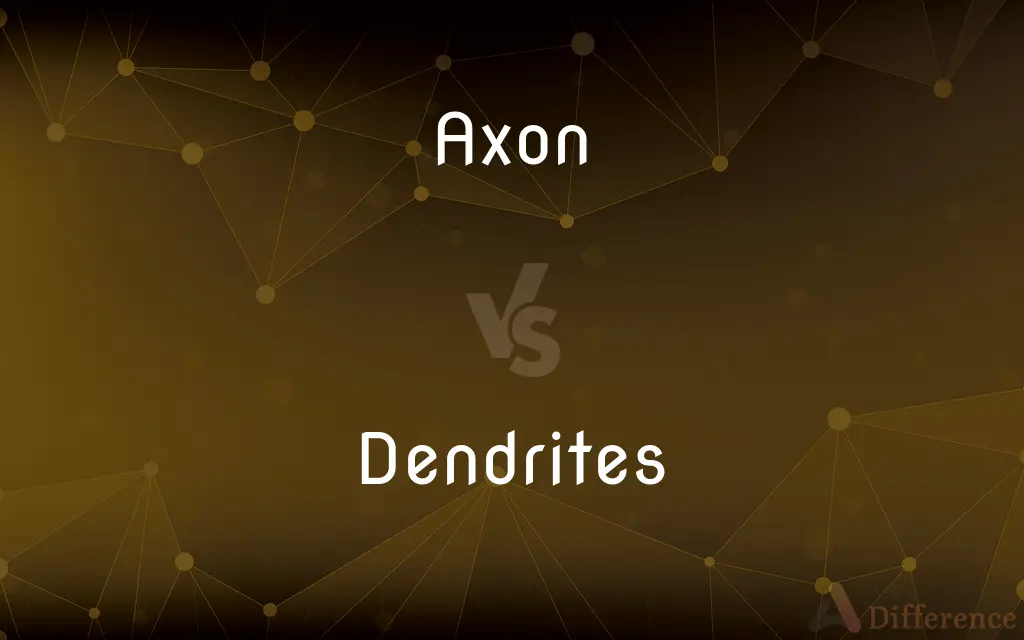Axon vs. Dendrites — What's the Difference?
By Fiza Rafique & Maham Liaqat — Published on October 11, 2024
Axons transmit electrical impulses away from the neuron's cell body, typically longer and fewer per neuron, while dendrites receive signals from other neurons, shorter and more numerous.

Difference Between Axon and Dendrites
Table of Contents
ADVERTISEMENT
Key Differences
Axons are specialized for conducting electrical impulses away from the neuron's cell body towards other neurons, muscles, or glands. They are typically long and singular in most neurons, facilitating the transmission of signals over distances. Dendrites, in contrast, branch extensively near the neuron's cell body to maximize the surface area for receiving signals from other neurons, making them shorter and more numerous.
The structure of axons includes a myelin sheath in many neurons, which insulates the axon and speeds up electrical transmission. Dendrites lack this myelination, focusing instead on the reception of signals through their dendritic spines, which are small protrusions that increase their surface area.
Axons end in terminal buttons that release neurotransmitters into the synaptic cleft, a small gap between neurons, to communicate with other neurons or effector cells. Dendrites contain receptors that detect these neurotransmitters, allowing the neuron to process incoming information.
The primary role of an axon is to transmit an electrical signal known as an action potential from the cell body to other neurons or muscles. Dendrites, however, mainly function to receive chemical signals from the neurotransmitters released by other neurons, which then get converted into electrical impulses.
Axons and dendrites differ in their ability to regenerate. Axons in the central nervous system have a limited capacity for regeneration, leading to more permanent damage when injured. Dendrites, being closer to the cell body and more numerous, can adjust more readily to changes, including damage.
ADVERTISEMENT
Comparison Chart
Function
Transmits electrical impulses away from the cell body
Receives signals from other neurons
Structure
Long and typically singular
Shorter and more numerous
Myelination
Often myelinated, speeding up transmission
Not myelinated
End Structures
Terminal buttons for neurotransmitter release
Receptors for detecting neurotransmitters
Role in Communication
Transmits signals to other neurons or muscles
Receives and integrates incoming signals
Compare with Definitions
Axon
The terminal buttons at the end of axons release neurotransmitters into synapses.
Axonal terminal buttons are crucial for neurotransmitter release during neural communication.
Dendrites
Dendrites are branching extensions of a neuron that receive signals from other neurons.
Dendritic trees elaborate to increase a neuron's receptive field.
Axon
Axons can be myelinated, enhancing signal speed and efficiency.
Myelinated axons in the nervous system allow for rapid reflex responses.
Dendrites
Dendritic damage can alter a neuron's ability to receive signals, affecting neural networks.
Neuroplasticity involves the modification of dendritic structures in response to learning.
Axon
An axon is a neuron's long, thin extension that transmits electrical impulses to other cells.
The axon of a motor neuron extends from the spinal cord to stimulate muscle contraction.
Dendrites
They contain receptors for neurotransmitters released by other neurons.
Neurotransmitter binding on dendrites initiates neural signaling.
Axon
Axonal damage in the central nervous system can lead to significant functional loss.
Axonal injury in the spinal cord may result in paralysis.
Dendrites
Unlike axons, dendrites do not typically have a myelin sheath.
The lack of myelination in dendrites reflects their role in signal reception rather than rapid transmission.
Axon
Axons facilitate long-distance communication within the nervous system.
The axons in the optic nerve transmit visual information from the eye to the brain.
Dendrites
Dendrites' extensive branching increases the neuron's ability to connect with multiple neurons.
The complex dendritic structure facilitates the integration of numerous synaptic inputs.
Axon
The usually long process of a nerve fiber that generally conducts impulses away from the body of the nerve cell.
Dendrites
A mineral crystallizing in another mineral in the form of a branching or treelike mark.
Axon
(cytology) A nerve fibre which is a long slender projection of a nerve cell, and which conducts nerve impulses away from the body of the cell to a synapse.
Dendrites
A rock or mineral bearing such a mark or marks.
Axon
Long nerve fiber that conducts away from the cell body of the neuron
Dendrites
A branched protoplasmic extension of a nerve cell that conducts impulses from adjacent cells inward toward the cell body. A single nerve may possess many dendrites. Also called dendron.
Common Curiosities
What distinguishes an axon from a dendrite in terms of function?
Axons transmit signals away from the neuron's cell body, while dendrites receive signals from other neurons.
Can neurons have multiple axons?
Typically, neurons have a single axon, but multiple dendrites to receive a wide range of signals.
Do all axons have a myelin sheath?
Not all axons are myelinated; it depends on the neuron type and its function within the nervous system.
How do dendrites contribute to neural processing?
Dendrites receive and integrate signals from other neurons, playing a crucial role in neural processing and response.
Is regeneration possible for axons and dendrites after injury?
Dendrites can adjust and regenerate more readily than axons, especially those in the central nervous system, where axonal regeneration is limited.
What happens at the terminal buttons of an axon?
Terminal buttons release neurotransmitters into the synaptic cleft, facilitating communication with other neurons or effector cells.
Why are dendritic spines important for neural function?
Dendritic spines increase the surface area of dendrites, allowing for more synaptic connections and enhancing the neuron's ability to receive and process signals.
How do axons and dendrites work together in neural communication?
Axons and dendrites work together by transmitting and receiving signals, respectively, allowing neurons to communicate effectively within neural networks.
What role do axonal terminal buttons play in neurotransmitter release?
Axonal terminal buttons are critical for the release of neurotransmitters into the synaptic cleft, enabling communication between neurons.
How does myelination affect axonal function?
Myelination increases the speed and efficiency of electrical signal transmission along the axon.
What is the significance of the myelin sheath in neurological diseases?
The myelin sheath's degradation in diseases such as multiple sclerosis disrupts neural signaling, leading to impaired sensory and motor functions.
Why are dendrites not myelinated?
Dendrites are not myelinated because their primary function is to receive signals, not to transmit them rapidly over long distances.
How does the length of an axon affect neural signaling?
The length of an axon can affect the speed and timing of neural signaling, with longer axons facilitating communication over greater distances within the body.
Can the structure of dendrites change over time?
Yes, dendritic structures can change in response to learning, experience, and injury, a phenomenon known as neuroplasticity, affecting neural connectivity and function.
How do axons contribute to the formation of the nervous system?
Axons contribute to the formation of the nervous system by extending from neurons to form connections with other neurons, muscles, or glands, establishing the network necessary for communication.
Share Your Discovery

Previous Comparison
Constructive Interference vs. Destructive Interference
Next Comparison
Physical Weathering vs. Chemical WeatheringAuthor Spotlight
Written by
Fiza RafiqueFiza Rafique is a skilled content writer at AskDifference.com, where she meticulously refines and enhances written pieces. Drawing from her vast editorial expertise, Fiza ensures clarity, accuracy, and precision in every article. Passionate about language, she continually seeks to elevate the quality of content for readers worldwide.
Co-written by
Maham Liaqat












































